

|
Íîìåð æóðíàëà: #3(4)
Ðóáðèêà:
Summary
From the editor
p. 2
The central event in Moscow’s architectural calendar is undoubtedly ARCH Moscow, the international architecture and design exhibition. This is an opportunity to see the profession’s established masters, discover new names, and witness new trends. This year, the 13th Arch Moscow will be part of the First Moscow Biennale of Architecture. It will also be the fifth such exhibition to include lighting. What was a small display in 2004 is now a section of the exhibition in its own right. The interest shown by lighting companies - and especially those whose products fall into the mid-price range or higher – remains strong, a reflection of the fact that this is an unparalleled opportunity for such companies to meet their target audience (architects and interior designers). A substantial part of the credit for promoting the idea of lighting design among this audience clearly belongs to the now defunct Illuminator magazine. An important role has also undoubtedly been played by seminars. Big names and outstanding lighting projects from all over the world have caught the attention not just of architects and designers, but also of planners directly involved in designing lighting systems. The editors of Prosvet magazine consider such work to be of the utmost importance. We intend to keep on doing it, and all the more so because we have experience in organizing such events and have built up good contacts with lighting designers, including world-class specialists. Our first event will be a seminar at ARCH Moscow. Roger Narboni, the famous urban lighting designer, will talk about designing lighting for individual structures and the urban environment as a whole.
Beating all the records
p.18-21
text Marina Novikova 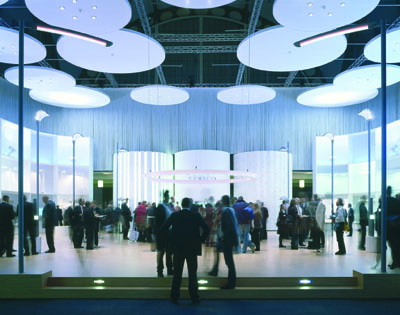
Frankfurt greeted us with a grey autumnal sky and a cold that was hardly expected in April. But a very different atmosphere awaited us in the Messe exhibition centre. The light flooding the complex’s halls would have been sufficient to warm and illuminate an entire city. Everyone was here: in addition to the giants of the international lighting market, there were hundreds of modestly sized and altogether small firms from all over the world. All in all, there were 2173 exhibitors – an enormous total. Even more impressive, though, was the number of visitors: 165,000 over six days. And almost a quarter of them were specialists such as architects, designers, planners, and installation experts.
The main impression made by the exhibition was that LEDs are everywhere. Companies whose stands did not feature some kind of product using diodes were the rare exception. It was only recently that LEDs were regarded as a trend, and whether semiconductor light sources would be widely used in lighting was a matter for debate. But now they are the mainstream.
The programme for Light + Building involved all kinds of forums and seminars, including ‘Russian Day’, an event which drew unfeigned interest from international manufacturers. This is perfectly understandable: Russia is an incredibly promising market due to the construction boom taking place both in its two capitals (Moscow and St Petersburg) and in ‘wealthy’ provinces, but also due to this market’s extremely complex character.
If you have never attended Light + Building, then it’s a must-do. Only in Frankfurt can you see the entire range of lighting equipment currently available and get a true picture of the lighting industry’s principal trade fair.
Luminale 08
p. 22-23 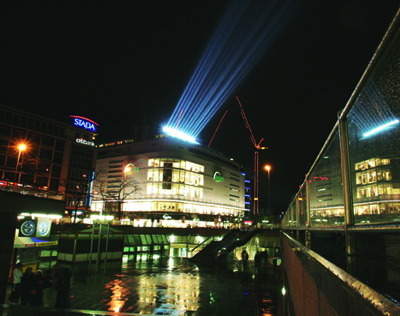
The biennial Luminale festival, held in Frankfurt am Main, is an event that is acquiring increasing importance - just like Light + Building, the world’s leading international lighting fair, which it accompanies. The organizers position Luminale as an international festival of lighting culture, a status which it certainly lives up to: it really has become an inextricable part of the main fair, a demonstration of how lighting equipment presented in the exhibition space at Messe Frankfurt may be used in practice. Moreover, the projects at Luminale are impressive not just for the diversity of techniques and solutions that they employ, but also for their unusually high artistic standard. This year, the city’s skyscrapers, museums, shops, streets, squares, churches, stalls, embankments, and bridges were for an entire week turned into an open-access lighting laboratory, a testing-ground for innovative equipment and bold experimentation.
For lighting designers and manufacturers Luminale is an ideal opportunity to demonstrate new lighting techniques and new products to an international audience mostly made up of visitors to Light + Building, including architects, designers, urban planner, and civic officials.
This year, the organizers say, the festival was attended by more than 100,000 people. Several bus routes picked up visitors directly from the central entrance to Messe Frankfurt to take them on tours of the lighting design and fine architecture of German cities.
Harmony of light
p. 30-35
text Ekaterina Galyuk 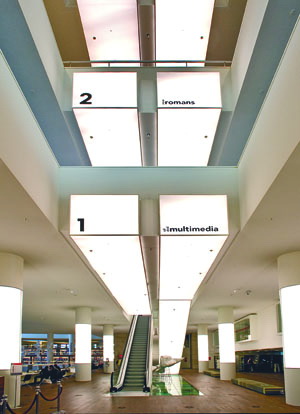
This year, Amsterdam is the UNESCO World Book Capital. The Dutch capital has played an important role in literary life from the 17th century forwards and so it comes as little surprise that it has recently gained a new library.
The library building was designed by Dutch architect Jo Coenen, whose idea was to build something ‘restrained, but not dull’. The lighting concept was developed by Rogier van der Heide of Arup Lighting. In work on the project account had to be taken of many restrictions of both an economic and ecological nature. The result is some unexpected and innovative solutions in architecture and lighting design.
The building is an unusual shape: the first floor is smaller in area than those above it, making the building seem to grow in height and width. It is this shape that inspired the architect to make maximal use of natural light. Daylight is everywhere here, thanks to a carefully thought out distribution system.
Strict conditions required that the lighting system overall consume not more than 12 Watts per square metre. This dictated that standard general lighting be rejected in favour of using local systems where needed while, wherever possible, doing without electricity altogether. The result is a solution which integrates the entire ‘lighting system’ into features of the building’s architecture and interior design. It is this that gives the purity and lightness of space which you sense when you enter the building.
Spanish nights
p. 40-43
text Natalya Merenkova 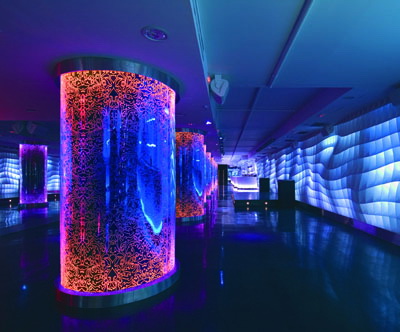
Madrid with its wealth of clubs and bars to suit every possible taste is deservedly known as the capital of European nightlife. An excellent opportunity to get a sense of the city’s infectious nocturnal pulse is a visit to the La Reina Bruja club. The interior was designed by Tomas Alia, one of Spain’s best-known club designers. Here he has created a striking atmosphere in which lighting plays a central role.
Upon entering, visitors see a large rectangular room with mirror walls. Right at the entrance is the reception desk, three glass cubes that radiate a soft white light. One of the walls, which stretches inwards from the entrance, has a complex cellular structure and constantly changes shape along its entire length as it keeps step with the designer’s imagination. Lit from within, this wall resembles an interior from a city of the future as depicted in a 1960s sci-fi film. Columns decorated with an intricate graphic pattern serve as an invisible boundary between the dance floor and the relaxation zone. The ornamental pattern is etched onto translucent polycarbonate lining the columns. The polycarbonate sheets are lit from the top and bottom, illuminating the ornament with a light which is soft in the middle of the columns and brighter at their ends.
The curving walls, dance floor, columns, bars, and even the toilets are lit by LEDs, which paint the club all colours. There is light in every line in the interior of La Reina Bruja, and it changes in time with the music, creating the feeling that Spanish architecture itself is capable of dancing all night long.
Raquel Cohen’s oceans
p.52-55
text Elena Chornaya 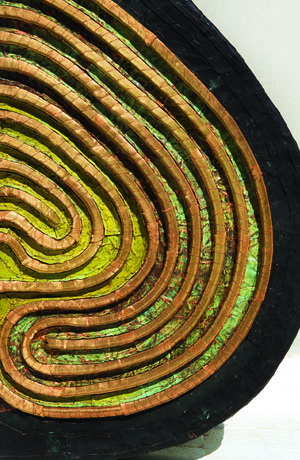
Very little is known about Raquel Cohen. In fact, we know only what she herself deems it necessary to tell. She prefers talking about mystery, light, femininity in art, and man’s links with nature.
It is not even very clear whether she should be seen as an American artist living in Spain or as a Spanish artist of American origin. This is a matter on which she herself is in no hurry to shed light. She values her North-American roots, but considers Spain – or, to be more exact, Catalonia – to be her home.
Raquel Cohen lived for a long time in South America. Her first exhibitions were in Lima, Santiago, and Buenos Aires. During this period her art was nourished by the Pacific Ocean. She gained her understanding of light, however, from Barcelona. The sea and light are two elements that have found expression in her works. In spite of the spatial associations stirred up by the titles of her series (Asteroids, Labyrinths, and Cosmos), the ‘maritime’ nature of their origins is all too clear. As a basis for her works Cohen uses copper wire, to which she then attaches an ‘armour’ consisting of pierced strips of copper and brass and patinated foil. These Raquel sews together using metal threads before decorating the surfaces with translucent tubes made of latex or plastic. Inside, halogen lamps are fastened in place using silicon. These precious ‘light vessels’ emit slender rays of light that cast fantastic shadows, transforming the surrounding space entirely. When their lights are turned off, the lamps show another side of their character – proving remarkably tactile. One can’t help wanting to subject the complex texture of their surface to intense and protracted scrutiny.
The Early Future Lamp: world premiere
p. 58-59 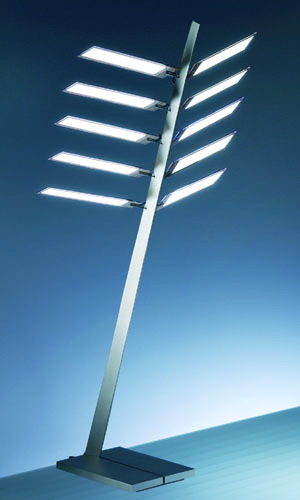
Organic LEDs are innovative light sources that have only recent emerged from the laboratory, but will soon become a part of people’s everyday lives. Proof of this is the Early Future Table Lamp, the first functional device to use light-emitting organic diodes. It is the fruit of collaboration between OSRAM and designer Ingo Maurer.
Ingo Maurer is often called the father of modern lighting design. His career began in 1966, when he presented his famous Bulb, a luminaire shaped like the most popular and common light source of the time, the incandescent bulb. Now Maurer has turned his attentions to the new
generation of light sources. For his new creation he uses panels covered in light-emitting organic links. These possess all the advantages of LEDs: extremely low energy consumption, a low operational voltage, and a construction that contains no dangerous substances. The main advantage of organic diodes, though, is that light is emitted not by individual luminous spots but by the entire surface. Maurer himself was responsible for designing only the shape and construction of the Early Future Lamp. The ten small LED panels (132 x 33 mm) on a slender leg resemble both a small tree and the feathering of an arrow. The panels can be revolved in relation to the tabletop, making the direction of the light adjustable. The new light sources were developed and realized by staff at OSRAM Opto Semiconductors.
Stairway to heaven
p. 60-61 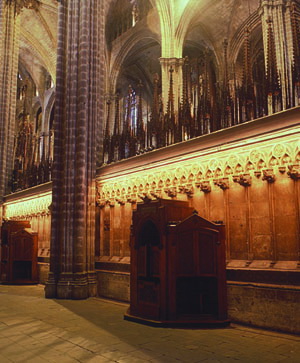
Youri Agabekov, owner and main ‘motor’ of AGABEKOV SA, took his first steps in architectural lighting in 1968, when he set up his first company, ARLUMINA, in Geneva and took out his first patent for a low-voltage lighting system. He developed Louvre, a low-voltage xenon lamp designed specifically to illuminate the facades and inner courtyard of the Louvre in Paris, in 1993 and, this year, renamed the company to AGABEKOV SA, an international lighting company which has since carried out architectural-lighting projects for several very famous buildings. His projects for the Académie française in Paris, Place Stanislas in Nancy, the National Palace in Mexico, the Palace of Monaco and 50 patents have made Youri Agabekov an acknowledged master in lighting based on the natural diurnal light produced by warm-tone Xenon lamps.
Since then Youri Agabekov has worked incessantly to perfect his linear low-voltage lighting systems, to which he has devoted his talent as an engineer. The numerous patents he has received are evidence of his achievements as an innovator. Lighting systems made by AGABEKOV SA can be used in a variety of applications – from lighting interiors and building facades to illuminating exhibition exhibits and shop window displays.
Now, as the third millennium gets underway, AGABEKOV SA has kept abreast of the latest technology by developing AGA-LED, a diode device for architectural lighting that will lead its field for decades to come.
Light from nowhere
p.62-63 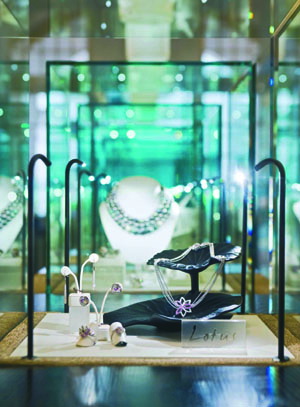
‘To be genuinely good, lighting equipment must avoid being flashy or eclipsing the light that it creates.’ This sums up the credo of Danish company Roblon, one of the leading producers of fibre-optic lighting systems.
Roblon’s specialists modestly conceal from sight their achievements, preferring to make their highly advanced technology and outstandingly functional design solutions invisible to the public – all those for whom grand lighting installations are created in the streets of the world’s major cities and for whom the most famous museums and galleries, refined jewellery shops, and popular shopping centres are illuminated. Roblon’s light fittings stand out for their unique ability to fit in quietly with their surroundings, revealing themselves only to the extent to which this is concordant with the overall architectural and design concept.
And yet, for all that they tend to keep to the background or are completely unnoticeable, Roblon’s lighting fixtures are paragons of advanced design. Take a look, for instance, at the company’s new collections of ‘smart’ downlights (Bebor, Nova, Note, and Avant-garde), underwater lights (Aquarius), and lighting systems (XPO and Brass). Distinguishing features include: a luminous beam that can be adjusted with extreme precision, including with respect to width; a 360o turning ability; the ability to combine diffuse and spot lighting in a single system; and variable shape. All this makes Roblon’s products models of flexibility and multifunctionality, qualities which are so prized by interior decorators and architects today.
Travel notes
p. 64-68
text Nikolay Schepetkov, professor of architecture 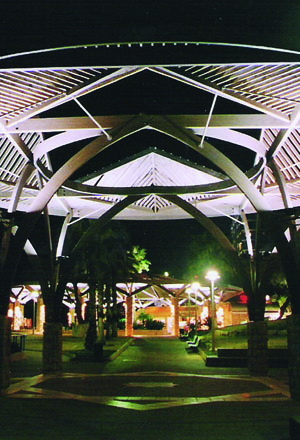
Israel is a country with an event-packed history that goes back many centuries. It is the cradle of three world religions which exist in a relatively local geographic space and continue to compete for ownership of extremely important historical relics. This complex historical past and by no means simple present are reflected in the architecture of Israel’s cities, its material objects, and life as seen not just in the light of the generous and sometimes withering sun, but also in the multiplying rays of electric lighting.
Jerusalem, Tel Aviv, Netanya, and Eilat are cities that vary considerably in age, geographical position, size, and architecture. My overall impression of Israeli lighting in the course of a short tourist trip was that lighting design is here only just beginning to catch on.
During the day, Jerusalem cannot fail to impress with its monolithic mass of architecture and unified colours. But when dusk falls, electric light transforms the city’s biblical image, making it almost unrecognisable. The city centre is dominated by the illuminated mighty wall of the old city with its towers. Pairs of powerful projectors are mounted in the ground alongside the wall, throwing onto it a slightly patchy (in terms of colour and brightness) pattern of light and shade, which is given rhythm by the darker rectangular shapes of the projecting towers. The square in front of the Jaffa Gate enjoys an unremarkable panoramic view of the lights of Western Jerusalem, which is dominated by a scattering of yellow sodium streetlights set off by occasional spots marking individual buildings.
Peerless light
p.70-72
text Rogier van der Heide
People today spend most of their time in buildings with artificial environments. We have grown accustomed to being able to exercise complete control over climate, smells, sounds, and electric lighting. But natural light too is ‘programmable’. The development of computer programmes and equipment for controlling natural light has allowed designers to create spaces that meet all modern requirements, are functional, and yet do not require heavy expenditure on electrical lighting. But the risk of such an approach is that buildings become characterless. To avoid this, natural light should be treated as an emotional component of an interior.
Work on such projects should begin with a study of conditions affecting levels of natural light (e.g. latitude and climate) in the location where the building is situated. A map of levels of illumination is then compiled. The next stage is to determine permissible levels of natural light penetrating the interior of the building. When designing lighting projects for museums, for instance, an important consideration is the amount of time for which exhibits can be exposed to light. Subsequently, indices for illumination levels are compared with the ‘through-flow’ capacity of the windows. The latter are then fitted with blinds, special glass, or other devices. Such so-called ‘static’ daylight systems create indoor lighting that is more dynamic because it incorporates changes occurring naturally during the course of the day. This kind of vitality is something we would like to see in lighting projects in Russia.
|